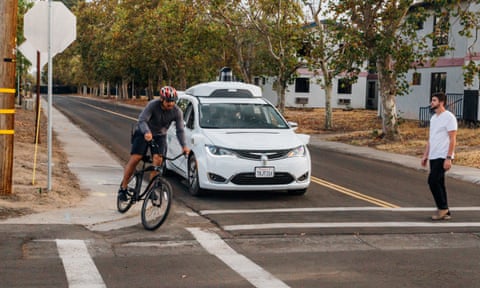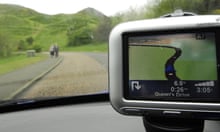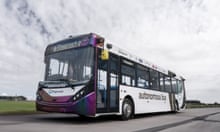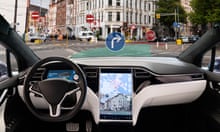In the manicured grounds of a public library in Chandler, Arizona, Liisa Walimaa is waiting for a robot to take her to Macy’s.
For a year Walimaa has been a participant in a closely guarded experiment being run by Waymo, a division of Alphabet (née Google), in this suburb of Phoenix that could change the face of global transportation on a scale unseen since we ditched horses for cars.
Automated vehicles offer the promise of fewer road fatalities, cheaper rides and greater mobility for the blind and otherwise disabled. They could also cost millions of jobs, threaten public transport spending and upend insurance. Technology companies may love to talk about “disruption”, but what is happening in Chandler is genuinely worthy of the word.
There have been setbacks (there will be more) and progress has been slower than first promised, but Walimaa thinks that in five or 10 years, autonomous vehicles will be as viable an option as taking a bike, calling a regular taxi or using your own car. Right now, she knows which she prefers.
“I’m so done with driving,” says Walimaa, a British-born writer and yoga teacher. “I love my car, but I don’t want to drive it any more.”
Walimaa is one of about 400 people who successfully applied to be in the Waymo early rider programme. Until now they have not been allowed to speak to the press.
“I am always more confident in a Waymo than I am in an Uber,” says Walimaa in her first interview on her experience. “Because I know it is going to be consistent. I do think it’s safer.” Last time she took an Uber to the airport, she says, the driver was texting on the freeway as they drove. “In rush hour. It was terrifying.”

Waymo’s self-driving Chrysler Pacifica hybrid minivan traverses public roads in Chandler, Arizona. Photograph: Waymo
A white Chrysler Pacifica minivan with what looks like an outsized black taxi light draws up. There is a person in the front – Waymo still has supervisors in its vehicles for some rides – and we are off.
There is something existentially spooky about watching the wheel turn on its own as the person in the front sits idly by, but otherwise the ride through Chandler’s wide, flat streets is utterly unremarkable. A screen shows our route and the position of cars, people and bikes around us. Does our vehicle seem slow on the left-hand turn? Maybe. A bit cautious, sure.
But it also feels totally safe.
Over the year Walimaa has been testing the service, it has improved enormously, she says. When she first started, the routes Waymo took could be “interesting”: “There was one time when I was very curious when it decided to go through a car park instead of taking the road.”

One of three screens displays the user interface inside a Waymo vehicle in Chandler, Arizona. Photograph: Caitlin O’Hara/Reuters
In two in every 10 rides the supervisor has to override something, she says, nonchalantly. I check my seatbelt – that sounds like a lot to me, but Waalima says “they are minor things”. On one ride the vehicle “had a mind of its own”, but she was never in danger and the supervisor took over. And if there were no supervisor? “Nine months ago I might have said something different, but now I’d feel comfortable contacting Waymo to sort it,” she says.
Walimaa may be at the cutting edge of change but she’s also in the minority in her enthusiasm. Polls show 52% of people say they would not use a robot car, and after an initial rush of hype, the onset of the age of the robot car has stalled.
In 2012 Google co-founder Sergey Brin said you could “count on one hand” the number of years it would take for most people to have access to autonomous cars. In 2019 the public are still waiting.
There are good reasons to go slow. A year ago a self-driving Uber killed a pedestrian in nearby Tempe, where Uber had more than 300 people employed in its own autonomous vehicle programme. The test driver “may have been streaming an episode of The Voice at the time of the crash”, according to cellphone documents obtained by Gizmodo, and the car didn’t alert the driver to take over the vehicle. Uber has since suspended the Tempe test. Volvo, Ford, Tesla and others have all suffered setbacks.
And yet billions of dollars are still pouring into autonomous vehicles. The robot revolution may be slower to arrive than first expected, but Waymo clearly thinks it is still coming.
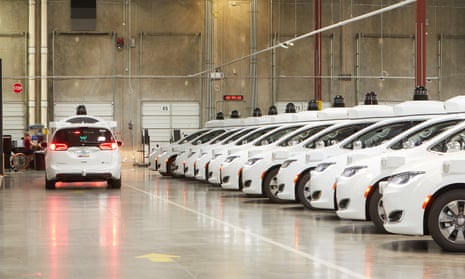
Waymo’s robot army
In an anonymous 70,000 sq ft warehouse on the edge of town a robot army waits to be deployed. Waymo currently has 600 autonomous vehicles on the road and has ordered 62,000 more Chrysler Pacificas and 20,000 I-Pace self-driving cars from Jaguar.
The closely guarded facility is filled with vehicles that en-masse look a little like four-wheeled Daleks. A handful of engineers check the cars before they are sent out on rides. The scene is more tech firm than taxi depot with the inevitable table football and ping-pong.
The slowing rollout of driverless cars may have cooled expectations but it hasn’t fazed Dan Chu, Waymo’s head of product.
“If you look even just a few years back ... I think everyone thought this was a glimmer in the eye, science fiction,” he says. “Now everyone’s like: ‘Oh, why isn’t this here yesterday?’”
The adoption of autonomous vehicles will in part be a numbers game, Chu predicts. Currently, 94% of serious accidents are caused by human error in the US, and he says the number of fatalities is actually going up.
Until autonomous cars become widespread on roads, public education on their safety is essential. “People will believe it when they see it,” says Chu. “When they actually get to experience the service and it’s actually showing how we can make the roads safer and be a convenient service for them, that’s when they become our biggest advocates.”
Waymo’s incremental approach is intentional, says Chu: “There’s a push and pull here. On one hand as a company we feel like safety is urgent. With over 1.2 million lives [globally] lost to traffic accidents on the roads, we want to move as fast as we can.” But “an incremental rollout is the best way to do it”.
So are we years or decades away from this technology being commonplace? “I think we are in the years,” says Chu.
Chandler’s mayor, Kevin Hartke, is already preparing for a driverless future.A huge new car park is under development and the city insisted that builders develop the project with conversion in mind. Driverless cars won’t need conventional downtown car parks so when and if they become commonplace, Hartke wants that space converted to other uses.
Other cities are watching closely. Hartke and his team have had visitors from all over the world since the project began. “It’s tremendously exciting,” he says. Meanwhile, local reaction has been mixed.
According to local police, Waymo vehicles have been targeted at least 21 times in the last two years. Tires have been slashed, rocks have been thrown and in one case a man threatened a Waymo with a handgun.
But in a city of 254,000, 21 such incidents in two years isn’t a huge number. Some of the incidents were by repeat offenders, and most were minor crashes caused by human drivers. Hartke says there is no real backlash against Waymo in the city. “It’s been such a minority,” he said. “There is not a fear or suspicion in our community.” Overwhelmingly, “it’s normal”.
Local resident Dave Wissenbach is not convinced. A programmer and avid cyclist, he is disturbed that Chandler has allowed Waymo to use his streets for an experiment he is unconvinced is ready for the real world.
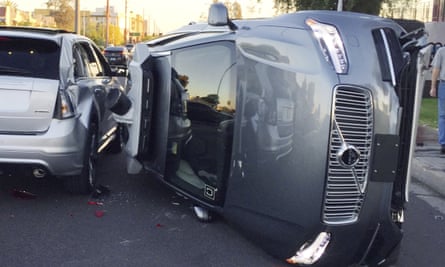
An Uber self-driving SUV that flipped on its side in a collision in Tempe, Arizona, in March 2017. Photograph: AP
Sheltering from unusually heavy rain in a bandstand in a local park, Wissenbach says the Waymos worry him. The first time he complained was when one cut him off in a bike lane. “It probably didn’t understand what a bike lane was,” he says. “The Waymo will do things inexplicably. Humans are more predictable.”
His complaint was met with a message that made him think Waymo believes it’s on “a mission from God for the greater good”. “Ultimately they may be right, it may be for the greater good,” he says, but the local community should have more input.
Not all the scepticism about Waymo is technological. Ashley Nunes, of the Massachusetts Institute of Technology’s Center for Transportation and Logistics, thinks money, rather than tech, may be the ultimate downfall of automated vehicles. Nunes is currently finishing a paper that argues they will ultimately be too expensive to ever seriously threaten conventional cars.
While that may seem an obvious point for the average car driver today (compare the cost of a Tesla with that of a second-hand Subaru), he says it doesn’t work for cabs either.
Cab companies make money charging drivers an hourly rate to drive their cabs. Waymo (and Uber and Lyft) are planning on replacing those (paying) drivers with technology that will require highly paid programmers and 24-hour live support. That isn’t going to make them cheaper, he predicts.
“People want to talk about the tech, people want to talk about the ethics. No one wants to talk about the cost,” he says. Nunes calculates it costs 72 cents (55p) a mile to run a conventional car in San Francisco and $1.58 (£1.20) for an automated taxi.
For companies like Uber and Lyft, whose sky-high valuations are based in part on a belief that they will one day rule transportation with robot cars, those numbers are a problem. “You are not going to get those societal changes if you can’t get that price down dramatically,” he says.
Regulatory roadblocks, consumer mistrust, job fears, costs – so many things could go wrong for Waymo. There’s no guarantee this technology will take off, and not all of Google’s bets work out – remember Google Glass?
Over in Scottsdale, another Phoenix suburb, Mike Pinckard, CEO of Total Transit, is one cab and transportation operator who disagrees with Nunes. “The past is the best indicator of of what’s going to happen in the future,” he says. Costs will come down and – he predicts – more people who seldom take taxis will switch over as they do. What we need to think about now, he says, is not when or if, but how we are going to deal with the consequences.
This is “a once in a lifetime” transition, he says. In 2014 there were 4 million Americans who drove for a living and Goldman Sachs has predicted autonomous vehicles could claim 300,000 of those jobs each year as the technology peaks. Ultimately, Pinckard believes, government intervention will be needed to manage the massive changes automated vehicles will bring.
Chu says the shift will create as well as destroy jobs. “The economy definitely has shifts and changes and we want to be part of supporting it and investing in that,” he says.
In New York, cab driver Sohail Rana, a member of the Independent Drivers Guild, is certain the robots are coming – and that in a way they are already here. Ride-share companies like Uber and Lyft have already outsourced back-office jobs in taxi companies and destroyed the livelihoods of many drivers, he says.
The next wave of tech will be devastating, he predicts: “It’s round the corner. And it’s going to take millions of jobs.” Immigrants – for whom driving is often a first job – will be hit first and hardest and the drivers who built companies like Lyft and Uber will be left behind, he says.
“The tech companies have not been good for us,” he says. “We have to start thinking about this now.”
Follow Guardian Cities on Twitter, Facebook and Instagram to join the discussion, catch up on our best stories or sign up for our weekly newsletter
